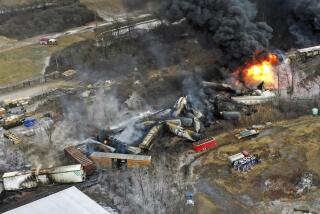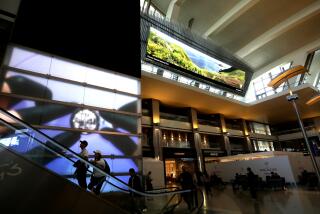Angels Flight has had a long, bumpy track record
In theory, the tiny railway was a quaint, enduring witness — watching as commuters gave up horses and buggies for tail-finned Cadillacs; as the prim Victorians atop Bunker Hill gave way to rooming houses and then shimmering skyscrapers; as downtown Los Angeles went from bustling to decrepit and back again.
In practice, Angels Flight has become an emblem of the way in which Los Angeles preserves and celebrates its young history: imperfectly.
On Thursday, the National Transportation Safety Board revealed that in the months before a September derailment, operators of the historic railway had been using a small tree branch to hold down the start button to keep the trains running.
The railway’s two cars had been running haltingly in the weeks leading up to the derailment, which caused no injuries. Holding down the start button appears to have been an attempt to override a safety system that might have been detecting a problem, the NTSB report suggested. Angels Flight management was aware of the use of the stick, authorities said.
Angels Flight has been around for 112 years — no small piece of history by Los Angeles standards. But it’s been closed for roughly a third of that time, shuttered by accidents and worn-out wheels, stashed in a dingy warehouse to make room for urban renewal projects.
Now it’s closed again, indefinitely.
In recent years, local officials and regulators have voiced worries about the integrity of the railway. Federal investigators raised red flags about the emergency braking system and wheel wear, among other things. In 2010, they urged the operator to build emergency walkways along the side of the tracks so passengers could safely evacuate. The operator argued the emergency exit would make it more hazardous for riders, and no walkway has been built.
Now, some officials are demanding new assurances that the railway is safe.
“In this case results are what matter, and we’d like to see some results,” said Rick Coca, a spokesman for City Councilman Jose Huizar, who represents downtown. “I think everybody thought these types of issues had been dealt with.”
On Friday, visitors hoping to take a famously short, rumbling, 33-degree ride from Hill Street up to Olive Street were greeted instead with still silence, a bleak reminder that Angels Flight is an enigmatic icon, beloved and bedeviled all at once.
“It’s such a simple thing,” said Tim Lee, who lives two blocks from the funicular and used it several times a week. “How come they can’t keep it open?”
Beyond its convenience, Angels Flight is — or should be — “the gem of the neighborhood,” Lee said.
“When people come to L.A., it’s the first thing I show them,” he said. “They’re always like, ‘Wow, I didn’t know L.A. had this thing. I thought it was all suburbs.’”
Not in 1901, when a civic booster who had served as a colonel in the Civil War financed the construction of what was then known as the Los Angeles Incline Railway. It cost a penny to ride, took 45 seconds and was built to connect the opulent homes on top of Bunker Hill with the jobs downtown.
Angels Flight was billed not only as the shortest commercial railway in the world — though there’s some dispute about that — but the busiest. By the 1950s, its two cars, Olivet and Sinai, made 400 trips each day, carrying 5,000 commuters — more than 100 million in its first 50 years.
But the core of Los Angeles has always been defined more by change than stability. As the city’s wealthy residents abandoned the urban core in droves, downtown and its adjacent residential neighborhoods were driven to decay.
By 1969, it was enough of a gaping wound in the metropolis that Angels Flight was closed for a vast renewal project — which included flattening Bunker Hill, literally, and replacing what had become slum housing with modern, sometimes glistening development. Angels Flight would remain closed for almost 30 years.
In 2001, five years after reopening just down the street from its original location, Angels Flight suffered its worst accident. Due to what federal investigators later described as a design flaw, one car careered down the hill and struck the other, killing an 83-year-old passenger, injuring seven others and closing the railway for the next nine years.
And now this. No one’s sure how long this closure will last, and authorities have been uncharacteristically tight-lipped about it.
Angels Flight Railway Foundation President John Welborne referred calls and emails to his press representative, who did not comment for this article.
The California Public Utilities Commission, which inspects the railway and will have the final say on resuming operation, said its investigation is continuing.
Representatives from the NTSB were furloughed on Friday due to the government shutdown and could not be reached for comment.
Repairs to Angels Flight could be extensive; the NTSB report outlined “urgent” recommendations, including preventing excessive wheel and track wear and maintaining emergency stop systems.
Mark McNally, executive manager of the Duquesne Incline in Pittsburgh, said maintaining a functional funicular can be a challenge. The Duquesne Incline opened in 1877, has been preserved with original cars and is one of a handful of historic funiculars in the country.
“There’s nothing we can buy off the shelf,” he said, adding that his railway hasn’t had an accident in recent memory. “Sometimes it would be so much easier just to bring in something new and replace it.”
Meanwhile, on Friday, Olivet and Sinai were parked on the tracks near the top of the hill. People climbed the 120-plus stairs leading to the top, many breathing heavily as they carried briefcases or lunch from Grand Central Market.
Pausing on the steps, co-workers Yolanda Castro and Monte Cook said the funicular was popular among those at their office — a quick way to travel to and from Grand Central Market. The pair said they had planned to take Angels Flight the day it broke, but opted to stay at work instead. They said the incident didn’t surprise them.
“I was always scared to death,” Castro said. “Even though they fixed it, it always felt like it was about to go …”
“Snap,” Cook interjected.
“It shouldn’t be that hard to fix,” Castro said. “It’s not going through turns. You’re not on the Matterhorn.”
“It’s just up and down,” Cook said. “Up and down.”
Advocates for downtown Los Angeles — both its history and its revitalization — will be watching closely.
Richard Schave, co-founder and operator of Esotouric, has been giving tours of downtown for seven years. Several of his tour groups have gotten stuck on the railway —once for so long, passengers had to crawl out of the cars onto the tracks, he said. Some tours no longer board the funicular as a result, a tough decision to make about such a crucial piece of the area’s history, he said.
“You can’t talk about old Los Angeles without talking about Angels Flight,” he said. With the railway dark, he said, “it’s a downtown with one less physical tie, connection to its past, which is my greatest concern. The less historical context there is, the less there is.”
More to Read
Sign up for Essential California
The most important California stories and recommendations in your inbox every morning.
You may occasionally receive promotional content from the Los Angeles Times.













